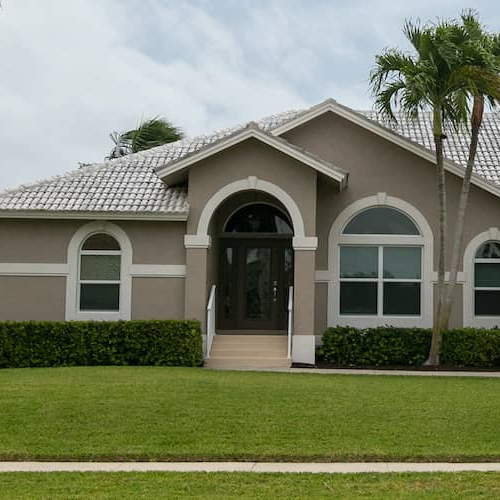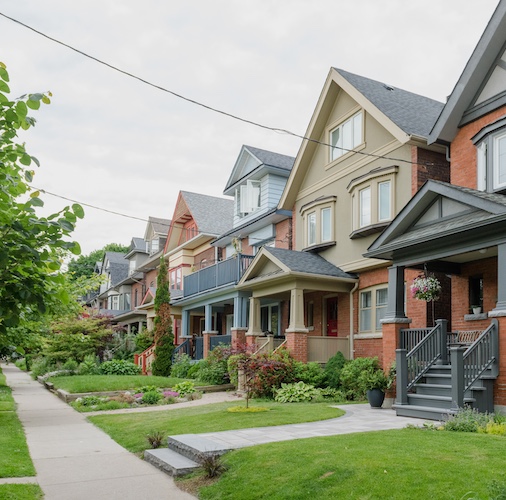What is an interest-only mortgage?
Contributed by Sarah Henseler
Nov 1, 2025
•6-minute read

When you get a mortgage to buy a home, it’s crucial that you’re able to keep up with your monthly payments. One way some borrowers temporarily reduce their monthly payment is by choosing an interest-only mortgage.
With a traditional mortgage, part of your monthly payment goes to principal and part goes toward paying interest. An interest-only mortgage lets you pay only interest for a certain number of years, typically 3 – 10, which lowers your monthly payment during that time.
However, once that period is over, you’ll need to start paying interest and your monthly payment will be higher. Here’s a look at how interest-only mortgages work and the pros and cons of this type of loan.
Interest-only mortgage defined
Interest-only mortgages are a type of nontraditional mortgage that aren’t as widely available as conventional loans and government-backed loans.
Like conventional loans, interest-only loans typically come with 30- or 15-year terms. But, because you’re only paying interest at the beginning, you’ll have a shorter amount of time to repay the principal. It’s important to be sure you’ll be able to afford to make higher payments once the interest-only period is over.
Interest-only loans were more popular prior to the Great Recession. However, because they pose more risk to lenders, they’re now considered nonqualified mortgages and are not backed by Fannie Mae or Freddie Mac.
How does an interest-only mortgage work?
Most interest-only loans are adjustable-rate mortgages (ARMs) which means your interest rate will also change at the end of the introductory period. Your monthly payment is likely to increase, and then your interest rate will adjust again on a recurring basis – typically annually or every 6 months.
Remember, your payment will also increase once the interest-only period ends and you begin paying principal. The end date of the lock period on your interest rate may not correspond with the end of the interest-only period. That means your payments could increase before the interest-only period ends and again once it does.
Interest-only mortgages have two phases – an interest-only phase and an amortization phase. Let’s go over a few quick facts about both.
Interest-only phase
During the interest-only phase, you only have to pay the interest on the money you’ve borrowed. This period typically lasts anywhere from 3 – 10 years. During this time, your monthly payment is lower because you don’t have to pay any of your principal balance like you would with a traditional mortgage.
However, that means your monthly payments will be that much higher when the interest-only period ends. It also means that you won’t be building equity during this time - which is the amount of the home you actually own. The only way you can build equity during the interest-only period is if the value of the home increases or you voluntarily make separate additional principal payments.
Some borrowers choose to refinance to a traditional mortgage near the end of the interest-only phase instead of moving onto the amortization phase. This can be a way to switch from an ARM to a fixed-rate mortgage before the interest rate starts adjusting.
Amortization phase
The amortization phase is also known as the principal-plus-interest phase and it’s when you can start building equity. This period will look more like a traditional mortgage, where a higher portion of your early payments will go toward interest and a smaller percentage goes toward chipping away at your principal. As time goes on, more of each payment go toward paying down the principal.
However, your monthly payments during the amortization phase will be even higher than a traditional mortgage because you have a shorter amount of time to pay off the principal. If you have an interest-only ARM, your payments can also fluctuate and likely increase when the rate-lock period ends.
Interest-only mortgage example
Let’s walk through an example of how payment works on an interest-only mortgage. Suppose you take out a $350,000 [1] 30-year fixed-rate interest-only mortgage. Your interest rate is 6.5%, your interest-only period is 7 years and your amortization period is 23 years. To keep the example simple, these figures won’t include property taxes and homeowners insurance, which vary based on the value of the home and where you live.
During the interest-only period, your monthly payment would be $1,895.83. Once the interest-only period ends and you enter the amortization period, your monthly payment would increase by $550.90 to $2,446.73. Let’s see how those numbers compare to what you’d be paying with a traditional fixed-rate mortgage.
|
Mortgage type |
Interest-only |
Traditional |
|
Initial monthly payment |
$1,895.83 |
$2,212.24 |
|
Amortization monthly payment |
$2,446.73 |
$2,212.24 |
|
Total interest |
$484,545 |
$446,404 |
|
Total loan cost |
$834,545 |
$796,404 |
Pros and cons of interest-only mortgages
Before you choose an interest-only mortgage, it’s important to fully understand all the advantages and drawbacks of this loan option.
Pros
Some of the potential perks of an interest-only mortgage include:
- More affordable initial monthly payments
- You may be able to afford a more expensive home.
- A lower initial interest rate with an interest-only ARM
- You’ll have cash flow during the interest-only period.
- You may be able to refinance or sell before the amortization phase.
- Potential tax advantages
Cons
Interest-only mortgages come with downsides to consider, such as:
- You can’t build equity during the interest-only period.
- Larger monthly payments after the interest-only period
- Potential interest rate hike with an ARM
- More total interest paid
- Higher overall cost in the long run
- Higher default risk
- Potentially stricter loan qualifications
Is an interest-only mortgage right for you?
It’s important to weigh the pros and cons of interest-only loans against your long-term financial goals to determine if this is the loan option for you. Consider your income expectations and ability to afford the initial payments as well as the higher payments down the line. Here are some cases where an interest-only loan can make sense:
- You expect your income to increase during the interest-only phase, so it won’t be a problem making the full payments when it’s time.
- You plan to sell or refinance before the amortization phase so you won’t live in the home for a long time.
- You have assets - like retirement savings - that will liquidate before the amortization phase.
- You’re comfortable with delaying building equity in exchange for lower monthly payments.
If you expect your income to increase over the next few years and could benefit from the initial lower monthly payments, this loan option might make sense for you. However, if you may not be able afford the higher monthly payments.
FAQ
If you still have questions about interest-only mortgages, we’ve got answers.
How does an interest-only mortgage differ from a balloon loan?
Like an interest-only loan, balloon loans also offer low monthly payments. The difference with a balloon loan is that you’ll have to pay the remaining balance with one large lump sum at the end of the loan term. Balloon loans also have shorter loan terms than interest-only loans and traditional mortgages. Because you’ll owe a significant amount all at once at the end of a relatively short term, balloon loans are considered higher risk for borrowers.
What are the qualifications for interest-only mortgages?
While the exact eligibility criteria for an interest-only mortgage will vary depending on the lender, you’ll typically need:
- A credit score of at least 680
- A down payment of at least 15%
- A low debt-to-income ratio
- Income verification
What are interest-only mortgage alternatives?
If you don’t think an interest only loan isn’t the right fit for you, here are some alternative mortgage options:
- Conventional loans are mortgage that are not backed by the government. These loans can be cheaper than government-backed loans but have stricter eligibility requirements.
- Government-backed loans are mortgages that are backed by a government agency. This reduces the risk lenders have to take on, which allows them to loosen eligibility requirements.
- Jumbo loans are mortgages with an amount that exceeds the current limit for conforming conventional loans. Because they are larger loans, they have stricter eligibility requirements and require a larger down payment.
Can I switch my current mortgage to one that is interest only?
If your financial situation has changed and need to reduce your monthly payment for a few years, you can refinance to an interest-only loan. This can be helpful for homeowners who have lost their job or have new unexpected expenses. However, you’ll stop building equity for the interest-only period and you’ll need to meet your lender’s refinance requirements.
What happens if you pay off an interest-only mortgage early?
Paying off your mortgage early will reduce the total cost of the loan and help you build equity faster. However, some lenders charge a prepayment penalty if you pay off your mortgage early. Rocket Mortgage® does not charge prepayment penalties.
Bottom line: Consider all of your mortgage options
Interest-only loans can be a way to reduce your monthly payment for the first few years of your mortgage. However, you won’t be building equity during the interest-only period and your monthly payments during the amortization period will be larger. You’ll also end up paying more interest overall for this type of loan. Be sure to consider your needs and loan options to find the right mortgage for your goals and financial situation.
If you think an interest-only mortgage might be right for you, start your application for a mortgage today.
[1]The payment on a $350,000 30-year fixed-rate loan at 6.375% is $2,183.55. The annual percentage rate (APR) is 6.638% and the loan-to-value ratio (LTV) is 80% for the cost of 1.75 points ($6,125.00) due at closing. One point is equal to one percent of the loan amount. Payment does not include taxes and insurance premiums. The actual payment amount will be greater. Rates shown valid on publication date of September 18, 2025. Some state and county maximum loan amount restrictions may apply.

Rory Arnold
Rory Arnold is a Los Angeles-based writer who has contributed to a variety of publications, including Quicken Loans, LowerMyBills, Ranker, Earth.com and JerseyDigs. He has also been quoted in The Atlantic. Rory received his Bachelor of Science in Media, Culture and Communication from New York University.
Related resources

8-minute read
What is a nontraditional mortgage?
“Nontraditional mortgage” is a broad term for home loans that aren’t a 30-year fixed mortgage. Here’s how they work and how to qualify f...
Read more

8-minute read
What is an adjustable-rate mortgage (ARM)?
Adjustable-rate mortgages offer low introductory interest rates that change over the life of a loan – with limits. Find out whether an ARM is right for yo...
Read more

8-minute read
Different types of mortgages and how they work
There is a home loan for everyone, but which type of mortgage is best for you? Use this article to understand the types of home loans and how they work.
Read more